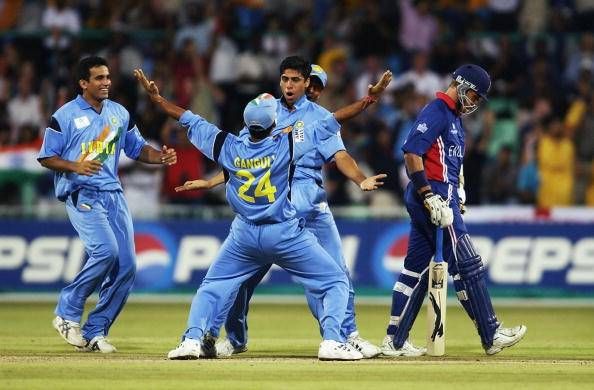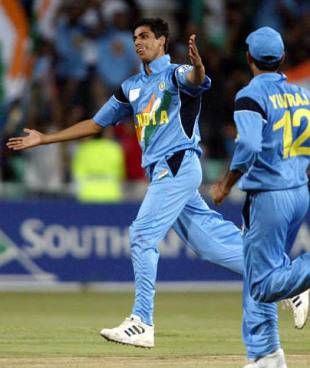
When Ashish Nehra ripped the heart out of the England top-order
The World Cup of 2003 was being held for the first time in the rainbow nation of South Africa. There were huge expectations from the defending champions Australia, the hosts South Africa, and few other teams.
Several experts were reluctant to include India in that list due to their dismal showing in New Zealand a few months earlier. The batsman had failed to show sufficient application of their skills, and even though on certain occasions, the bowlers made good use of the helpful conditions on offer, the hosts proved just too good for them in both Tests and ODIs.
India’s form, or the lack of it, was on display in the opening game of the competition itself when they could manage just 204 while batting first against Netherlands in Paarl, and if it was not for an inspired bowling effort from the likes of Javagal Srinath, Zaheer Khan and company to take their side past the finish line, they might have faced an embarrassment at the hands of the minnows.
Australia gave them a hammering in the next match, the consequences of which were felt most severely back home as houses of most cricketers were attacked, leading to further trouble in an already gloomy-looking campaign.
After winning their next game against Zimbabwe in Harare, India headed to Durban to face England in a critical contest. After electing to bat first the Indians managed to put up 250 for 9 in their 50 overs with Rahul Dravid scoring 62 and Yuvraj Singh scoring 42.
It was by no means a match-winning total, but it certainly was a competitive one, and with Durban renowned for its history of assisting swing bowling in the evening, it promised to be an absorbing second session.
Ashish Nehra wasn’t meant to play this match, as a few days earlier in the match against Namibia, he had injured his leg after bowling just a solitary delivery and had kept his ankle in a bucket of ice for the whole day before the match against England to keep the potential injury at bay.
The then captain Sourav Ganguly was obviously a worried man and on asking the physio Andrew Leipus about his condition, he was informed that if India were going to include him in the playing XI, they had to bowl him out in one straight spell rather than give 2 or 3 separated spells of bowling.
India began well, reducing England to 28 for 2 in the 12th over when Nehra was brought into the attack. Immediately, in his third over he struck removing Nasser Hussian off a ball that was just too close to cut, for 15.
Off the very next ball, he removed yet another big fish, Alec Stewart, with a fast inswinger that held its line after pitching, timed in at a 142.9 kph on the speed gun.
Ankle injury? What ankle injury?
The Indians were cock-a-hoop now and Nehra was breathing fire. He removed Michael Vaughan next, a man who had tormented the Indians the previous summer at the Old Blighty, for 20 with a ball that just pitched and swung away enough to take the outside edge.
Ganguly employed a wide slip for Nehra and that worked perfectly in the case of Paul Collingwood, who was dismissed for 18 by a delivery that almost squared the right-hander up, with just a hint of movement after pitching, but good enough for Virender Sehwag to do the rest.
Craig White was Nehra’s next victim and was dismissed to the delivery that England had gotten tired of watching during the course of the night: pitching middle, swinging enough, taking the outside edge and GONE.
The sixth and final wicket of Ronnie Irani had a bit of drama around it.
There was just one slip in place in the form of Dinesh Mongia. Nehra insisted that a second one be stationed next to him, and after some deliberation, Ganguly brought Sehwag to stand next to him.
The next ball pitched, squared Irani up, and was safely pouched by Sehwag at second slip. He finished the night with figures of 10-2-23-6, thereby breaking the record for the best bowling figures for an Indian at the World Cup, over-hauling Venkatesh Prasad’s figures of 5 for 27 that he took against Pakistan in the 1999 edition.
Needless to say that India went to win the contest, as they won by a margin of 82 runs thereby ensuring they remained in contention for a spot in the Super Six stage.
Ganguly lauded Nehra’s determination
Ganguly hailed his performance, saying that it was Nehra’s sheer determination that carried him through the night.
"He's had a swollen ankle for two days and it was sheer determination that made him play. He bowled a fantastic line. It's one of the best performances in a one-day international that I have seen since I started playing for India."
He finished the tournament with 15 wickets in 9 matches at an average of 19.26, and later revealed about how there was no fear within him right through the competition, simply because he was playing his first World Cup and said that at that stage, ‘all anybody wants is to go out and play.‘
He is now back in the Indian set-up after a long gap of 5 years, and at 36, continues to bowl at a nippy pace if not express. In the form of Jasprit Bumrah, he now has a young partner for company, who is now delivering at speeds that the veteran did during his maiden World Cup in 2003.
As he approaches his second T20 World Cup, the conditions may not be as favourable as they were in Durban that night, but if Nehra can prove to be as effective as he was then, he would have made the job very easy for MS Dhoni and India.

